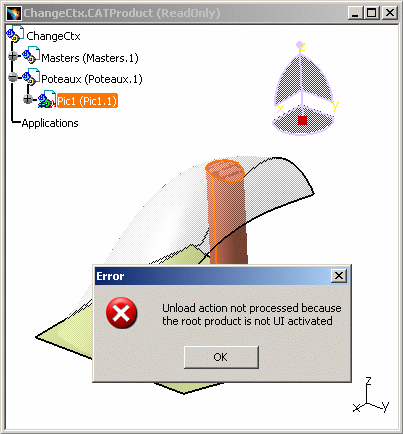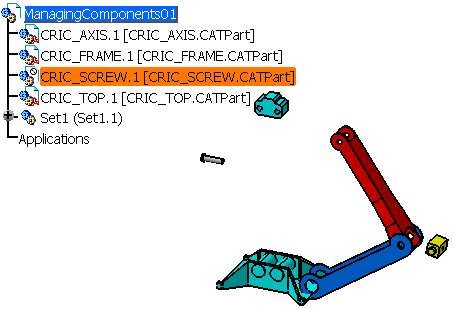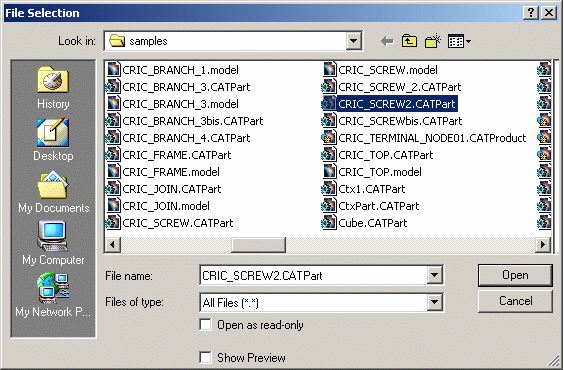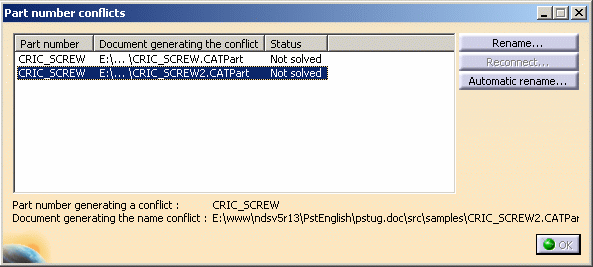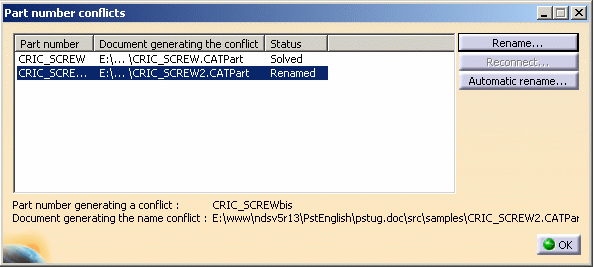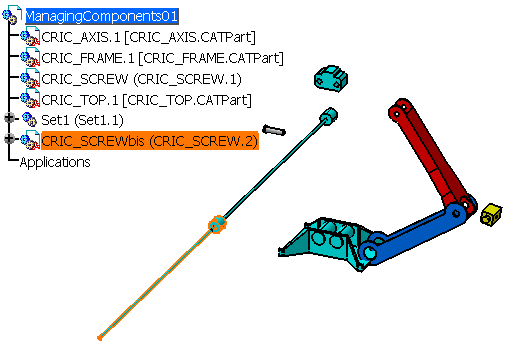 |
This task shows
you how to unload a component from an assembly. Unloading a component
means removing the document containing the Reference of the Instance. A
second section explains that if you unload a CATPart, then add an
existing component that has the same Part Number as the unloaded
component, and finally you reload this component, a Part Number conflict
occurs.
You can only unload CATPart and CATProduct documents in an assembly.
For a model document, you must use the deactivate representation
functionalities, see Managing Representations.
Unloading a CATIA document and reloading the same document after
several modifications in the CATProduct may lead to Part Number
conflicts. This aspect is explained in the second section of this
scenario: Managing Part
Number conflicts after a Reload. |
 |
When a .model
(*MASTER) is under a Component, you can select it and press the
Unload icon
 . . |
 |
- If the
Cache
is ON and you open a CATPart, it is not loaded (in Visualization mode) but
its geometry is visible in the 3D view. Reload it (in Design mode) and
then you activate the Unload functionality on this CATPart. This is
unloaded (in Visualization mode) and its geometry is visible, which means
that it goes back to the initial state.
With
the
Cache
status as
ON, performing Unload command on a CATPart Instance will in fact switch it
back to Visualization mode. The following scenario will explain you the
effects of this command.
- Actions performed after unloading components cannot be undone. The
history of actions is cleared and the Undo
icon is grayed out.
- An object that is UI-Activated, cannot be unloaded. The
UI-Activated object cannot deleted itself (cannot unload itself), this
is why an error message appears:
|
|
Unloading Components
|
 |
Open the
4cubes.CATProduct document.
You are in Visualization mode and the CATParts are unloaded (see
Picture 1 below). |
 |
-
Select CUBE.1 [Cuve.CATPart] in the Specification Tree
or in the geometry and click the Load icon
 .
CUBE.CATPart is loaded and it is reflected on all its Instances (see
Picture 2). .
CUBE.CATPart is loaded and it is reflected on all its Instances (see
Picture 2).
-
Unload CUBE.1. This component and all these instances
return into Visualization mode (see Picture 3).
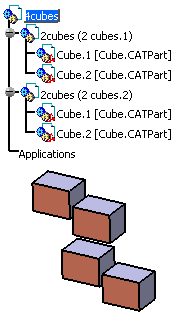 |
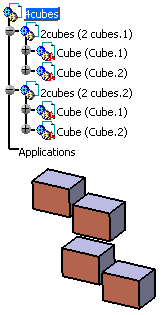 |
 |
| Picture 1: CATParts are not loaded (Visualization
Mode) |
Picture 2: Loaded CATParts |
Picture 3: CATParts are not loaded (visualization
Mode), the Cache is not activated). |
|
 |
If you did not
select the Cache option, the geometry of the CATPart disappears
and its icon indicates the unloaded status
 . Then, to reload the same
CATPart, select it and click the Load icon. Therefore, the Part
re-appears in the Geometry space and, in the Specification Tree, its icon
changes into the loaded status: . Then, to reload the same
CATPart, select it and click the Load icon. Therefore, the Part
re-appears in the Geometry space and, in the Specification Tree, its icon
changes into the loaded status:  . . |
 |
Unload command
launches the same window as
Desk (Point 8. in Using the FileDesk Workbench, in the
Infrastructure User's Guide). |
| |
 |
| |
Managing Part Number
conflicts on reload
|
 |
Open the
ManagingComponents01.CATProduct document. |
 |
-
Select CRIC_SCREW.1 (CRIC_SCREW.CATPart) in the
Specification Tree or in the geometry and click the Unload
icon
 .
CRIC_SCREW.CATPart has disappeared in the Geometry space: .
CRIC_SCREW.CATPart has disappeared in the Geometry space:
-
Insert another CATPart having the same Part Number as
the one of CRIC_SCREW.1 (CRIC_SCREW.CATPart), for instance:
CRIC_SCREW2.CATPart:
And you obtain:
-
Select CRIC_SCREW.1 (CRIC_SCREW.CATPart) and click the
Load icon
 .
A Part number conflicts window appears because CRIC_SCREW.CATPart and
CRIC_SCREW2.CATPart have the same Part Number CRIC_SCREW: .
A Part number conflicts window appears because CRIC_SCREW.CATPart and
CRIC_SCREW2.CATPart have the same Part Number CRIC_SCREW:
The OK button is dimmed because the second instance of
CRIC_SCREW has already been inserted in the CATProduct and now you
need to rename one of the Parts in order to resolve the conflict.
-
Click the Rename or Automatic rename
button. The Part Number window is displayed and you can rename the
CATPart. Then click OK:
-
The conflict is resolved because CRIC_SCREW2.CATPart has
been renamed. Click OK and the window will disappear:
And you can see that both instances of CRIC_SCREW are visible in
the Specification Tree and in the Geometry:
|
|
 |
